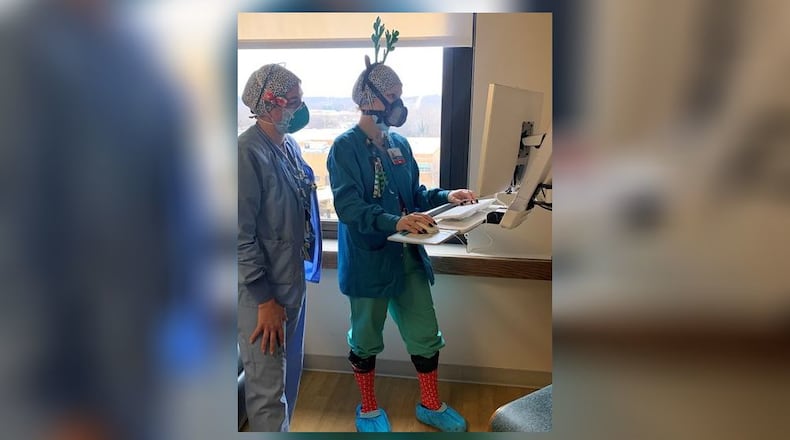Nurses caring for COVID-19 patients in hospitals and nursing homes and more are 10 months into the pandemic hitting Ohio and are now on the front lines of the biggest surge of infections yet.
Kuykendoll said she is not shocked by the number of people getting infected with the coronavirus, but she is surprised by the severity of cases in those seeking hospital care.
“What I am surprised about is the people that are coming in, how sick they are, and how quickly outcomes can change for them,” she said. ”For a short amount of time, between March and September, we saw there weren’t as many people ― not that there weren’t as many people being tested and being positive, but they weren’t as severely sick as they are now. We saw those people who were severe, but it is not as bad as it is right now.”
The impact of the rising spread is playing out in hospitals across Ohio. A flood of sick people is stretching nursing staffs thin, and the caregivers are getting sick. COVID-19 vaccines are now being distributed to hospital staff who are directly caring for patients with the virus but it will take time for the distribution to happen for all health workers. It is expected to be longer still for the vaccines to help reduce the inflow of patients.
Nurses are emotionally, physically and mentally tired because of the pandemic, said Kuykendoll. They become close to their COVID-19 patients, saying they are “near and dear to our heart” because of the amount of care they provide.
“We try to keep our schedule where we’re working two to three days in a row to keep continuity for our people, for our patients here because it’s good for them. We know what’s been going on for them in the past 48, 72 hours,” she said.
Many tears have been shed, said Kuykendoll.
“We are like a family and when we see one of our family members hurting, we all hurt,” she said. “We’ve shed many tears together on our floor, at our nurses’ station, in our patient’s room. When we have a patient that passes away, it’s not just our patient, it becomes our ... family’s patient. We all go in there, and we take care of that patient in a way that we can. It’s hard because we’re seeing quite a bit of loss and we’re working through it.”
When Kuykendoll heads home to her two teenage sons, it’s difficult “to just go home and to be able to enjoy everything.”
“I think when you talk to any of our nurses, on the way home they’re crying,” she said. “My kids are older so they understand ... and they’ll check in on me and make sure I’m okay. But it’s hard. You do feel withdrawn from your family. We feel like as nurses we’re supposed to be strong for everyone. When everybody else’s crashes down, we’re the ones that are holding it together.”
Heather Tubbs Cooley, PhD., RN, and associate professor at Ohio State University, who has researched nurse workload and quality, said the relationship between nurse staffing levels and patient outcomes in hospitals has been documented for decades.
“Nurse workload is a combination of several factors including the number of patients a nurse cares for (staffing ratio), the sickness of the patient (acuity), time pressure and work intensity during a shift. All of these are elevated right now in ICUs nationwide. This is unprecedented ― there is no slack in the system,” she said.
For example, ICUs are designed for nurses to have one or two patients, depending on how much care the patient needs. When a nurse has more patients than that, it’s difficult for them to be able to give focused care to each of those patients. COVID-19 patients can also be more unstable and their conditions can worsen quickly.
“We’re asking them really to work in impossible situations. And that’s very demoralizing for people to leave at the end of the day feeling like they didn’t do all that they wanted to be able to do for patients,” she said.
Then on top of that some nurses are getting sick or quarantining themselves.
Tubbs Cooley said hospitals could support nurses during the surge by finding safe ways to let families visit patients, which can comfort patients and take some of the emotional labor off of nurses.
Hospitals could also spend time cross-training nurses to have the skill sets to fill in different places, she said.
“This is not a fast fix and ideally hospitals were doing over the last several months. Nurses are educated as generalists in nursing school; a hospital then further prepares them in a particular specialty. Training ICU nurses takes months, not weeks or days,” Tubbs Cooley said.
She said hospitals could also bring more support staff so that ICU nurses can focus on core work like complex medication administration and continuous surveillance.
The biggest thing the public can do is to take steps to limit spread, she said. High workloads from the COVID-19 surge impacts people needing care because of the coronavirus but it also impacts people who need care because of other reasons, from car wrecks to heart attacks.
“If someone has let’s say a stroke and they need to go to the ICU, they may not be getting the intensity of nursing care that they would otherwise get just because the workload for nurses is so high,” she said. “We need the public to do their part so that every patient can get good care.”
Nurses are being heavily recruited locally and nationally. The Associated Press reported finding salaries as high as $6,200 per week on postings for travel nursing jobs. The AP reported nurses who work in intensive care and on medical-surgical floors are the most in-demand. Employers also are willing to pay extra for nurses who can show up on short notice and work 48 or 60 hours per week instead of the standard 36.
The Ohio Hospital Association reported in November that about 20% of hospitals were reporting staffing shortages.
“We certainly are seeing some unique challenges. But by the same token, we are actively recruiting and hiring for nurses, and still have a lot of individuals interested in working for Premier,” said Billie Lucente-Baker, VP for human resources with Premier Health.
Some nurses also have had to stay home with kids because of remote learning or child care disruptions.
Lucente-Baker said they’ve taken steps to help with workload and retention. They created a respite space where nurses can take a break without wearing personal protective equipment; they’ve provided meals for staff while they are working and have programs for emotional and spiritual support such as virtual group sessions.
Officials with both Premier and Kettering Health said they’ve started “Helping Hands” programs to move staff into other support roles they don’t typically work in, from delivering trays to patient transport, to help with work load.


